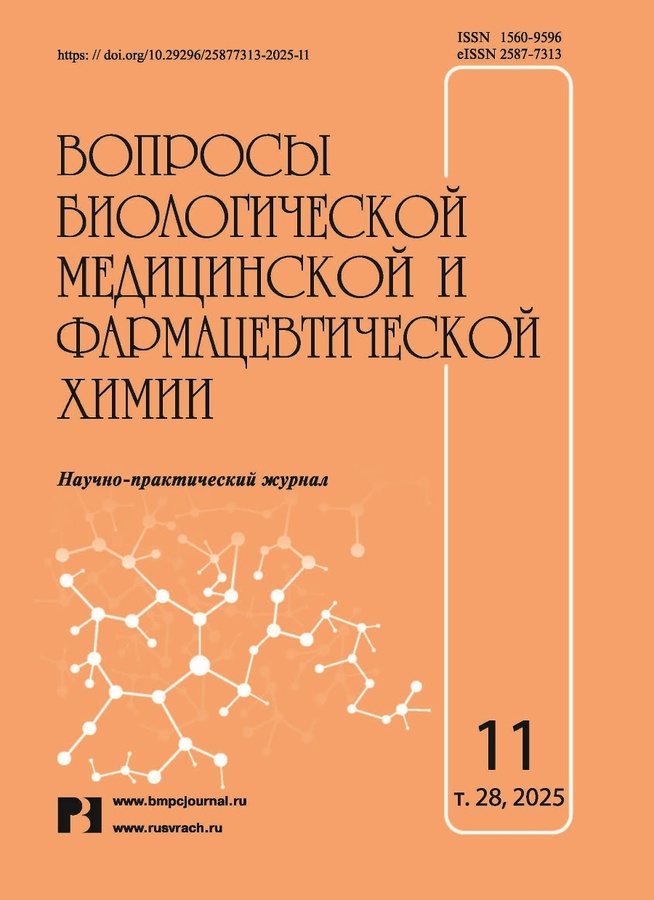Influence of cytoskeleton on rat erythrocyte acetylcholinesterase activity and propertie
- Authors: Abdurakhimov A.A.1, Aytmukhambetova I.R.1,2
-
Affiliations:
- Tyumen State University
- Tyumen State Medical University
- Issue: Vol 28, No 11 (2025)
- Pages: 101-106
- Section: Problems of experimental biology and medicine
- URL: https://journals.eco-vector.com/1560-9596/article/view/696279
- DOI: https://doi.org/10.29296/25877313-2025-11-13
- ID: 696279
Cite item
Abstract
Introduction. Acetylcholinesterase is a key enzyme of the cholinergic system that catalyzes the hydrolysis of acetylcholine into choline and acetate. This enzyme is found in the brain tissues and red blood cells of mammals. Studying its activity in membrane preparations of erythrocytes is relevant for diagnosing the effects of organophosphorus compounds and for developing methods to correct neurodegenerative diseases. The cytoskeleton of erythrocytes, which is formed by a spectrin–actin complex, plays an important role in maintaining the cell’s mechanical properties. The effect of cytoskeletal components on acetylcholinesterase activity provides a deeper understanding of this enzyme’s regulation.
Aim. We investigated how the cytoskeleton influences the activity and kinetic parameters of acetylcholinesterase in rat erythrocytes.
Material and Methods. Experiments were carried out on Wistar rats weighing 200–230 g, kept on a standard diet. Erythrocytes were isolated and subjected to hypoosmotic hemolysis to prepare ghosts (membrane preparations) and spectrin-free vesicles by removing part of the cytoskeletal proteins. Acetylcholinesterase activity was evaluated by the Elman et. al., (1961) method, expressed in micromoles of hydrolyzed acetylthiocholine. Kinetic parameters (Km and Vmax) were determined using the Lineweaver–Burk method.
Results. The enzyme activity in spectrin-free vesicles decreased by approximately 30 percent, although subsequent treatment with Triton X-100 restored the activity to levels comparable to those in erythrocyte ghosts. Analysis showed that the absence of the cytoskeleton did not affect Km or Vmax values, which confirms the stability of the enzyme’s catalytic properties. A reduction in protein content in the vesicles was verified by the Lowry method.
Conclusions. Acetylcholinesterase retains its functional activity after partial removal of the cytoskeleton. Treatment with detergent reveals a latent portion of the enzyme’s activity, which is associated with altered membrane orientation during vesiculation. These findings broaden the possibilities of using erythrocyte membrane preparations to model cholinesterase function under various physiological and pathological conditions.
Full Text
About the authors
A. A. Abdurakhimov
Tyumen State University
Author for correspondence.
Email: az.Abdurakhimov@gmail.com
ORCID iD: 0009-0002-7724-4436
Master's Student, Laboratory Research Assistant at the Laboratory of Agricultural Mycology and Plant Protection
Russian Federation, 6 Voldarsky str., Tyumen, 625003I. R. Aytmukhambetova
Tyumen State University; Tyumen State Medical University
Email: ilnara.serikova.01@bk.ru
ORCID iD: 0009-0001-8894-5871
SPIN-code: 6784-5837
Post-graduate Student, Master's Student, Assistant of the Department of Biochemistry named after A.Sh. Byshevsky
Russian Federation, 6 Voldarsky str., Tyumen, 625003; 54 Odesskaya str., Tyumen, 625023References
- Kazennov A.M., Maslova M. N., Shalabodov A.D. Investigation of Na/K-ATPase activity in mammalian erythrocytes. Biohimiya. 1984; 49(7): 1089–1095. (In Russ.).
- Lobzin S.V., Sokolova S.A., Nalkin S.A. Influence of brain basal cholinergic system dysfunctionon the condition of cognitive. Vestnik severo-Zapadnogo gosudarstvennogo meditsinskogo universiteta. 2017; 9: 53–58. (In Russ.). doi: 10.17816/mechnikov20179453-58.
- Bluma R.K., Kalinina I.E., Ivanova S.M. Investigation of the structural and functional properties of the erythrocyte membrane using fluorescent probes DSM and DSP-6. Biologicheskie membranyi. 1992; 9(5): 453–463. (In Russ.).
- Zhou W., Lv S. Delayed recovery from paralysis associated with plasma cholinesterase deficiency. SpringerPlus. 2016; 5: 1–4.
- Shi H., Liu Z., Li A. et al. Life Cycle-Dependent Cytoskeletal Modifications in Plasmodium falciparum Infected Erythrocytes. PLoS ONE. 2013; 8(4): 1–10.
- Mason J. The Recovery of Plasma Cholinesterase and Erythrocyte Acetylcholinesterase Activity in Workers after Over-exposure to Dichlorvos. Occupational Medicine. 2000; 50(5): 343–347. doi: 10.1093/occmed/50.5.343.
- Anikienko (Babushkina) I.V., Pivovarov Yu.I., Sergeeva A.S. et al. Сhanges in the interrelations between components of a proteinaceous rangeof the erythrocyte membranes in patients with hypertension. Biologicheskie membrany: Zhurnal membrannoi i kletochnoi biologii. 2019; 36(2): 137–146. (In Russ.). doi: 10.1134/S0233475519020038.
- Dodge J., Mitchell C., Hanahan D. The preparation and chemical characteristics of hemoglobin-free ghosts of human erythrocytes. Arch. Biochem. Biophys. 1963; 100(1): 119–130.
- Borovskaya M.K., Kuznetsova E.E., Gorokhova V.G. Structural and functional characteristics of membrane’s erythrocyte and its change at pathologies of various genesis. Acta Biomedica Scientifica. 2010; 3(73): 334354. (In Russ.).
- Lowry O.H., Rosebrough N.J., Farr A.L. et al. Protein measurement with the Folin phenol reagent. J Biol Chem. 1951; 193(1): 265–275.
- Steck T., Kant J.A. Preparation of impermeable ghosts and inside-out vesicles from human erythrocytes. Methods in Enzymology, Biomembranes. 1989; 3: 172–180.
- Petrov K.A., Kharlamova A.D., Nikolsky E.E. Сholinesterases: the opinion of neurophysiologist. Genyi i Kletki. 2014; 9(3): 160–167. (In Russ.).
- Nigra A.D., Casale C.H., Santander V.S. Human erythrocytes: cytoskeleton and its origin. Cellular and Molecular Life Sciences. 2020; 77: 1681–1694.
- Guiping W., David J., Zhuhao W. et al. Structural plasticity of actin-spectrin membrane skeleton and functional role of actin and spectrin in axon degeneration. eLife. 2019; 8: 1–22; https://doi.org/10.7554/eLife.387.
- Olszewska M., Wiatrow J., Bober J. et al. Oxidative stress modulates the organization of erythrocyte membrane cytoskeleton. Advances in Hygiene and Experimental Medicine. 2012; 66: 534–542.
- Ellman G.L., Courtney K.D., Andres V.J. A new and rapid colorimetric determination of acetylcholinesterase activity. Biochemical Pharmacology. 1961; 7: 88–95.
- Yagodina L. O. Application of the Ellman method to determine the kinetic parameters of the reaction catalyzed by Ratus Norvegicus Acetylcholinesterase. Vestnik Kazanskogo tehnologicheskogo universiteta. 2012; 15(22): 241–244. (In Russ.).
- Shalabodov, A.D., Maslova, D. N., Kyrov. The influence of membrane skeleton solubilized proteins of erythrocytes on the activity of na, k-atpase. Vestnik Tyumenskogo gosudarstvennogo universiteta. Seriya: Ekologiya i prirodopolzovanie. Tyumen: Izdatelstvo Tyumenskogo gosudarstvennogo universiteta. 2015; 1(1): 171–182. (In Russ.).
Supplementary files









